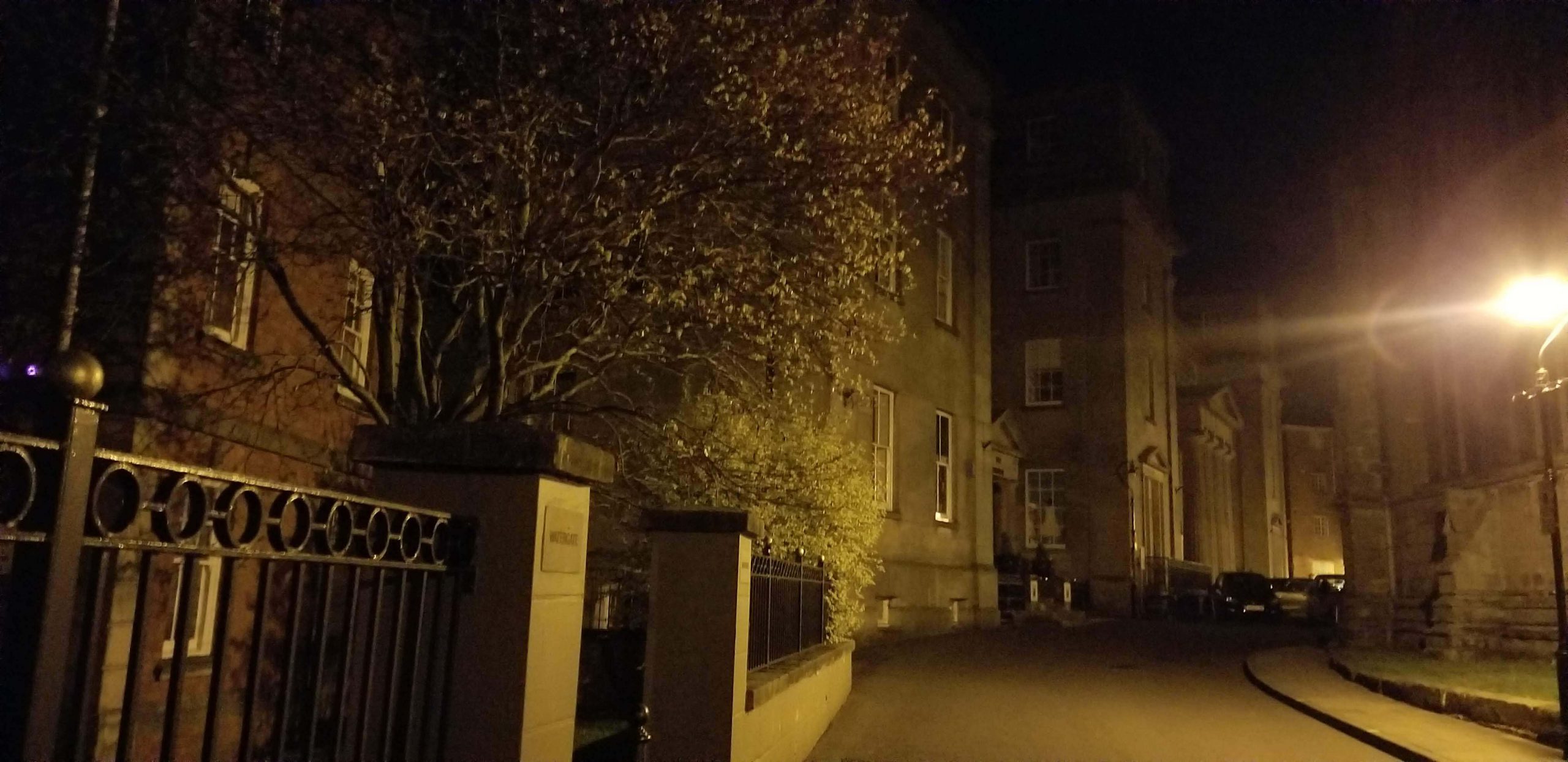Is Shrewsbury The Most Haunted Town In Shropshire? Well, with the number of tales of ghosts and reported eerie goings on in its historic streets, it could indeed be considered a strong contender for the title of the most haunted town in Shropshire and possibly even in England. This picturesque market town has witnessed its fair share of gore and conflict, most notably during the Battle of Shrewsbury in 1403, where an estimated 3000 lives were lost. The long and storied history of Shrewsbury contributes to the numerous ghostly tales that linger in its atmospheric surroundings.
Shrewsbury Train Station
The rather magnificent Shrewsbury Train Station was built in the early 1800’s and was once the gateway to the North, South and Wales. The station was regularly used by notable people. In the cold winter of 1888 a local Shrewsbury coal merchant and MP, Mr Thomas Thomas was waiting for his train to take him to London on platform 3. Regrettably, Mr. Thomas never made it onto the train. The station’s roof, burdened by a heavy layer of snow, unexpectedly collapsed, tragically crushing Mr. Thomas to death.
The platform is now rarely used now but Mr Thomas is regularly spotted as a dark suited figure standing near the platform’s ornate gates and ignoring waiting passengers from other platforms waving to him, he still awaits his London train.
In 1907, a second tragedy unfolded at the station. As a post office trolley accidentally rolled onto the tracks, two workers bravely leaped down in an attempt to free it. Unfortunately, their efforts ended in tragedy, as they were fatally struck by an oncoming train. To this day, many who walk along the platform recount sensing an eerie chill at the site of this unfortunate incident.
Castle Gates House
On the entrance path to the castle you pass a notable timber framed house, this is Castle Gates House. It was originally situated at the top of Dogpole however in the 1800’s the house was sold with the provision that the new owners moved it and indeed they did, taking it down piece by piece and rebuilding it!
Many passing by the house have experienced a strong ‘pull towards the house and have been unable to resist the urge to knock at the front door…..what could explain this…..

In the Civil War of 1645, Captain John Benbow made a fateful decision to allow parliamentary forces into Shrewsbury, leading to the surrender of the town. Following this, the commanding officer, although permitted to march his men to Ludlow, faced an unfortunate turn of events. A group of Irish soldiers, billeted in Shrewsbury at the time, met a grim fate as they were hanged the following day without a trial.
Realising the gravity of his error, Captain Benbow sought to return to his old unit at Ludlow Castle. However, parliamentary officers responded to his request by escorting him to the vegetable patch in Shrewsbury Castle, roughly where Castle Gates House now stands, and executing him by firing squad. As the tale unfolds, mysterious forces seem to linger around Castle Gates House, prompting speculation about whether they emanate from the spirit of Captain John Benbow or the unfortunate Irish soldiers.
Shrewsbury Castle “Bloudie Jack”
The original castle at Shrewsbury dates back to 1070 and was a Norman fortress built by Roger de Montgomery. Commissioned by a wealthy local family, Telford designed and shaped the castle to serve as their opulent family home However another far more sinister individual had once lived on the site, Shrewsbury’s very own medieval serial killer “Bloody Jack”.
In the 12th century a soldier named Jack Blondell was stationed at Shrewsbury Castle and went on to become the castle warden. Jack’s arrival in Shrewsbury coincided with a series of unsettling events involving the sudden disappearance of young girls. Various tales circulated about Jack’s methods, including seduction, luring victims back to his quarters, and committing heinous acts of violence before murdering the girls. Once the deed was done, he disposed of the remains in chilling ways, either by feeding them to the castle keep’s pigs or by tossing them into the nearby River Severn.
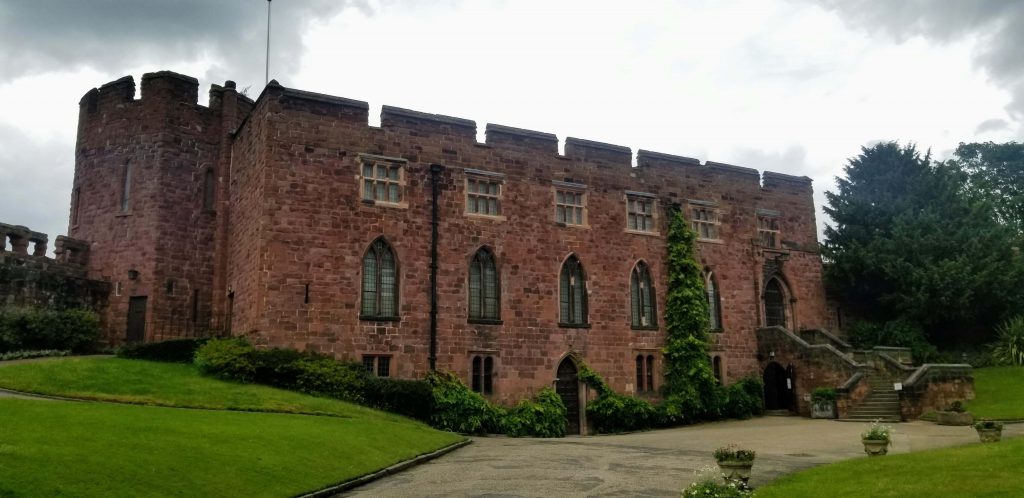
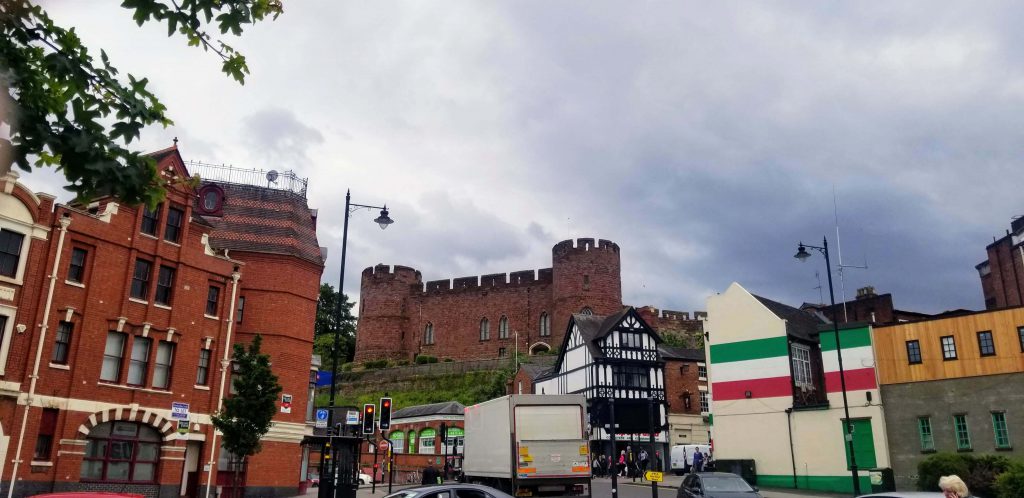
Jack’s downfall came when he seduced a young girl named Mary-Anne. Mary-Anne had told her sister about meeting Jack. When Mary-Anne did not return home her worried sister went searching for her and discovered Jack dragging poor Mary-Anne’s body across the castle’s forecourt. Mary-Anne’s petrified sister fled the scene and informed authorities. When they came to investigate they discovered a wooden chest in Jack’s quarters, neatly inside the chest were eight sets of fingers, Jack’s trophies from his victims.
Thankfully Jack’s cruelty came to an end, and quite a grisly one. After his trial and a guilty verdict, his punishment was to be hung, drawn and quartered. Beyond the grave Jack still makes his presence known. Many witnesses have reported seeing a man followed by a group of women weeping. Jack is also often spotted on his own, his ghost appears by a door on the castle ground level and walks along over the lawn until he reaches the area that was once the Norman’s Chapel and vanishes.
Inside Shrewsbury Castle is now the regimental Museum where it has been reported you can hear a pair of boots walking over the balcony. The balcony was removed over 30 years ago!
Parade Shopping Centre
The Parade Shopping Centre and flats have a historical origin as the Royal Shrewsbury Infirmary, established in the 1700s. Serving as a hospital for centuries, it played a crucial role in the community until the 1970s.
Our first ghost is thought to be a hospital matron, who likes to throw things onto the floor at night.
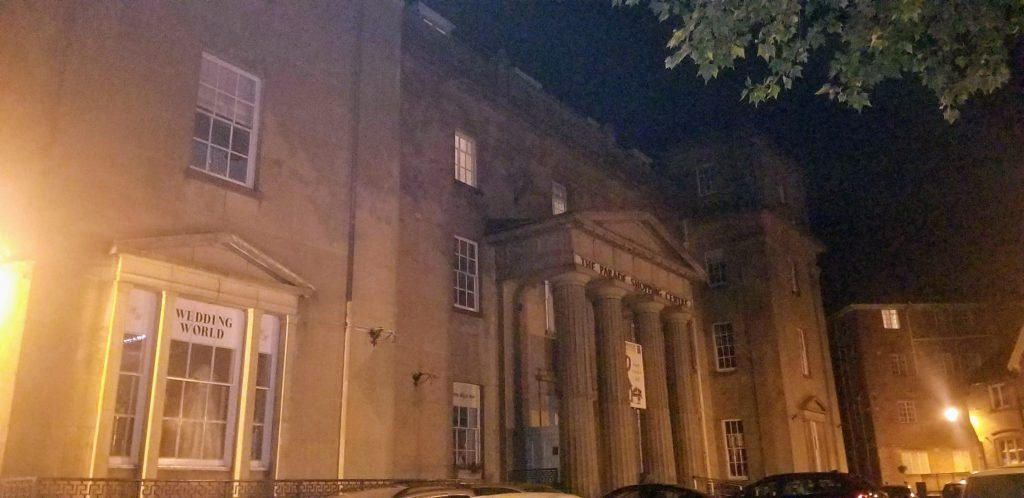
The next ghost, known as the Grey Lady, carries an air of sinister mystery. During the era when The Parade functioned as an infirmary, numerous accounts recount her standing at the end of a patient’s bed. This was a very foreboding sight, all the patients whom she visited soon died, nurses even tried moving the patients whom she visited to a different ward to avoid the curse, but their fate was already sealed.
The Parade Shopping Centre is said to host a less ominous spectre—a gentleman lingering outside, perhaps patiently awaiting rations provided to the needy or assuming the role of a janitor. The chap stands outside waiting for a time before mysteriously fading away, well we all get fed up of waiting.
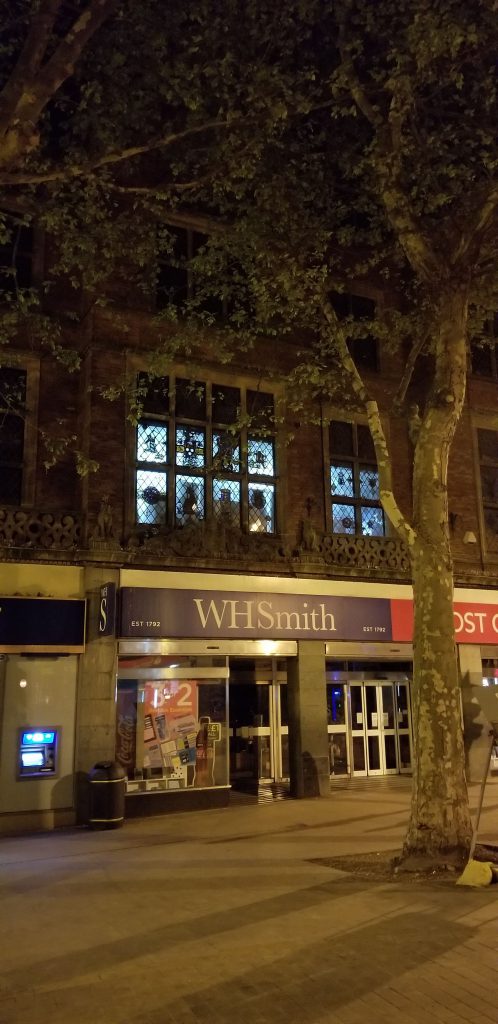
Pride Hill
Pride Hill is the main shopping street for Shrewsbury but holds a ghostly secret.
On the top floor of what is now WH Smith apparently a young woman appears and then fades! Long ago in the 1300’s, women accused of witchcraft faced a grim trial, they were dropped into the River Severn, if they sank they were innocent and if resurfaced then considered guilty and burned. Those found guilty faced burning at the highest point of the town walls, which just happens to be where WH Smith is today. Could this young lady represent a condemned woman accused of witchcraft, disintegrating as a manifestation of her tragic end.
Butcher Row
The name of the street in Shrewsbury says it all. The first cattle market in Shrewsbury was situated at the end of Butcher Row in St Alkmunds. Here, patrons selecting livestock had the convenience of guiding their chosen animals down Butcher Row for slaughter, over 200 a day killed. The hooks in the street that the butchers would hang the dead animals on can still be seen today. Many say they get a feeling of being watched and grey mists appear in the street, perhaps this could be the spirits of all the dead animals!
The Prince Rupert Hotel
The Prince Rupert Hotel is the ultimate spooky hotel in Shrewsbury, if you are looking for a ghost then this is the place to stay. The Hotel was once the former home of Prince Rupert, the grandson of King James I and parts of the hotel date back to the 12th century.
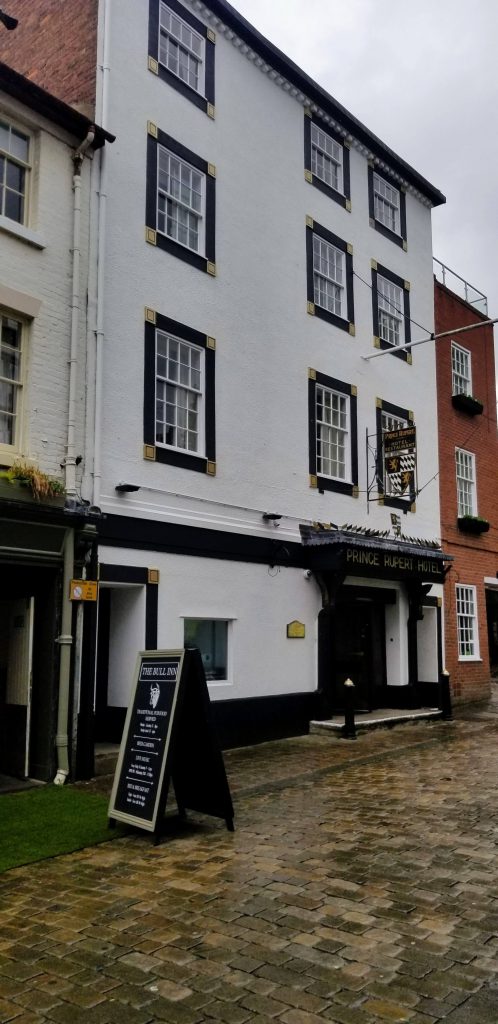
The spirit of a jilted bride resides in Room 5. During the Victorian era, a lady arrived in Shrewsbury to be married and stayed in room 5. However, on the eve of her wedding, she discovered her betrothed had abandoned her for another. Overwhelmed by despair, the distraught woman tragically took her own life by hanging herself from the beams within the hotel room. The spirit of the jilted bride is said to linger, causing mischief for any young single gentleman staying in the room—particularly by removing and rearranging the bedclothes.
The haunted reputation of room 7 is attributed to a jilted groom who reportedly took his own life within its confines. Witnesses have claimed to see the apparition of this gentleman, seated at the foot of the bed. It seems a great shame that he doesn’t find and court the lady in Room 5, what an eerily happy ending that would make!
The hotel’s basement also has more unexpected guests. During the 1980’s a medium who stayed at the hotel reported that a maid named Martha was asking why gunshots were being fired and went down a spiral staircase. The hotel had no known spiral staircase. A few years later the hotel underwent a refurbishment, under the floorboards they discovered the foundations for a spiral staircase. Even more creepy, they uncovered a skeleton dating to the mid 1700’s which coincided with the last known maid named “Martha” working there. Martha’s shadow has been spotted standing in the corner of the kitchen.
A small boy has been spotted by many, he stands by the outer retaining wall.
In another basement room there is a not so friendly presence, a man who likes to tell people to leave!
In 1984 the classic “A Christmas Carol” was remade and filmed in Shrewsbury. The cast and crew stayed at “The Prince Rupert”. One night, on his way back to his bedroom, Tony Imi bumped into a gentleman dressed in an old-fashioned nightshirt carrying a candleholder. Mr Imi greeted the gent but he ignored him. Mr Imi then realised the candle had no shadow, the man continued and walked straight through a wall!
Fish Street
St Alkmunds
At the top of Fish Street stands St Alkmunds with its striking spire. St Alkmunds was originally built in 947 but rebuilt in the mid-1700’s.
On that impressive spire at St Alkmunds has been seen the ghost of a steeplejack called George Archer. George apparently climbed the imposing steeple four times and entertained onlookers on the first two with a drum and jig. After George replaced the weathervane at the top of the spire he retired to the Three Fishes Inn for a beverage, (alcoholic I presume). Inside the inn, another chap made a bet with George to climb and retrieve the weathervane for a gallon of beer, George couldn’t resist and successfully completed the challenge. A while later, after George had consumed a considerable amount of his gallon beer, the chap who originally made the bet had a change of heart and asked George to return the vane, with promises of another drink when completed. George once more accepted the request and clambered on up, this time however he made a fatal mistake at the top, stepping back he fell to his death! It is said you can see his ghost climbing up the spire!
St Alkmunds, or well the street next to St Alkmunds contains a second ghostly presence. In 1725 the path was ordered to be widened which resulted in 6 graves being dug up from St Alkmunds. A man in dark clothing has been seen at the lower end of the Bear Steps at the shop, could this have been his rudely displaced resting place!
St Julians
At the lower end of Fish Street is St Julians Church. St Julians was built on the foundations of a Saxon Church. Today, only the 12th Century Tower remains from its medieval origins; most of the building was rebuilt in the 1770’s.
In the early 1800s, a visitor to Shrewsbury, accompanied by his chef named Taur, lodged at the Lion Hotel. One fateful evening, Taur experienced a choking fit, and by the time a doctor arrived, he was believed to be dead. His death certificate was quickly signed and a quick burial took place. Soon after horrified passers by reported hearing screams and shouts coming from the church. The source of these screams were traced to Taur’s burial spot. The grave was exhumed and it was discovered Taur had actually been buried alive, his fingers were worn down from scratching the coffin lid. Sadly it was too late to save him, Taur was now dead and reburied! Long after screams and moans could be heard until the area was finally exorcised in recent years and Taur’s ghost could rest.
Dogpole – Old House
Along Dogpole stands one of the oldest houses in Shrewsbury, fittingly named “The Old House”. Two ghosts still consider this house to be their home. The first is a gentleman who walks across the main entrance hall and down the stairs that once led to what was the kitchen. He then departs downstairs, an intriguing phenomenon unfolds: the enticing aroma of bacon begins to waft upstairs, accompanied by the distinct sounds of chopping.
The spectral presence of a lady gazing out of a window onto Dogpole, then turning away and departing, adds another layer of intrigue to the ‘Old House’. The discovery of a hidden passage behind the chimney in the room where the lady has been sighted reveals a connection to a small chapel. This suggests the possibility that the apparition may be tied to a historical era when individuals were persecuted for their religious beliefs, leaving a lingering ghostly presence.
Wyle Cop
Lion Hotel
The grand Lion Hotel, situated along Wyle Cop, boasts a storied history as a renowned coaching inn. Over the years, it has proudly hosted distinguished guests, including literary icon Charles Dickens, statesman Disraeli, and the famed Madame Tussaud. These days the Lion Hotel appears to accommodate a few guests from times gone by who are reluctant to vacate, the first being the grey lady. Inside the Lion Hotel at the foot of the stairs which lead to the Adam ballroom, the grey lady has been spotted waiting, but for waiting for what? Folks say she is waiting for her love to come and propose, unfortunately he never did, eventually she turns and walks away through the outer door, only the door no longer exists and instead she vanishes straight through a wall where it once stood.
Outside you are able to walk up a narrow passage at the side of the hotel which leads to where the car park stands, if you look up in the passage you will spot a window and above that the remains of an old archway. This archway is the old outer door where the grey lady leaves and vanishes halfway across the road.
Another mystery of the Lion Hotel is that of the sealed room. The blocked room is located above the curved staircase that leads to the Adam ballroom. The reason the room is locked away instead of earning income for the hotel comes from what lies within it. What occurred in this room is kept very hush, it is said a murder or terrible tragedy happened here. Staff refused to enter the room due to the malicious aura and the feeling of pure hatred that dwelled within, eventually the owners of the Lion Hotel decided to brick the room up. This has not stopped whatever dwells inside, visitors have reported disconcerting sounds of moans and groans emanating from the sealed room. Additionally, onlookers from the alley outside claim to have spotted a lit candle flickering in the window, further adding to the mystique and eerie atmosphere surrounding this particular space within the hotel.
The cellars in the Lion Hotel hold a secret, it was once a chapel and the ghosts of two ladies praying have been spotted deep down there.
The Nags Head
The Nags Head’s Inn dates back to as early as the 1400’s and has retained its name throughout history, although the exterior we see today is from the Tudor era.
The Nags Head appears to be a harmless pub, but on the top floor there is a little room with a menacing secret. Within the room lies a built-in cupboard, and on the interior of its door, an enigmatic painting of a prophet hangs. The presence of this painting remains shrouded in mystery, but the tales surrounding those who cast their eyes upon it are undeniably sinister. Legend tells of a curse woven into the painting—any who gaze upon it are said to succumb to madness, the room certainly has a foreboding history of that happening.
Within the confines of the inn, at least three trapped spirits are said to linger—unable to depart after their lives were abruptly cut short due to the curse linked to the mysterious painting. The first tragic tale revolves around a young maid who, having just innocently cleaned the cupboard, met a grim fate. In the evening, on the eve of her impending wedding, she tragically threw herself out of the window and beneath the wheels of a passing stagecoach. This haunting incident marks the beginning of a series of unfortunate suicides tied to the ominous curse.
Soon after the maid’s untimely death the curse hit again. A coachman who, seemingly in good spirits after securing a new job, met a harrowing end. On the morning he was set to embark on his new employment, the landlord of the Nags Head made a grim discovery—the coachman was found suspended from the rafters of the room.
During the period of the First World War. A young officer, returning home from the horrors of the trenches, chose to stay in the room. By the following morning, a grim fate unfolded— the officer was found dead, having taken his own life with a shot from his service revolver.
Following these horrific events the room was bricked up until the 1980’s, thankfully the curse has not struck again since the room was opened up.
Barracks Passage
Barracks Passage was named accordingly after its military history. During the War of the Roses, as Henry VII and his soldiers made their way to the Battle of Bosworth Field in 1485, Henry himself lodged at the front of Barracks Passage, while his soldiers found accommodation nearby. The officers received a warm welcome and experienced moments of joy during their brief stay at Barracks Passage before the fateful battle. Sadly, a significant number of these soldiers never returned, losing their lives on the battlefield.
The spirits of these fallen soldiers are said to linger, retracing their steps to the inn where they once found camaraderie and merriment. The present-day inn, now named Henry Tudor House, has reported sightings of these apparitions, with some witnesses claiming to see the ghostly figures suddenly appearing through the glass—a poignant reminder of the soldiers’ happier times before the tragedy of war unfolded.
Abbey Foregate
The Dun Cow
The Dun Cow is one of the oldest and spookiest of Shropshire’s haunted inns, when you step inside you may well feel you are stepping back in time. Built in the 11th century by Roger de Montgomery, whose uncle was no other than William the Conqueror.
The first ghostly punter at the Dun Cow is the mischievous ghost of a monk. Shrewsbury’s magnificent Abbey stands just across the road and you would have thought it would be a more fitting place for the monk, however this. Legend has it that if he disapproves of a customer, he expresses his mischievous nature by kicking their table in an attempt to spill their drink—a rather unconventional and cheeky haunt for this lively pub.
In 1980 Mrs Hayes, the wife of The Dun Cow’s landlord awoke to discover a hooded figure wearing the habit of a monk bent over her baby daughter’s cot. At being disturbed the creepy figure disappeared but it did not deter him from returning. Two years later Mr and Mrs Hayes were woken up by their daughter screaming and crying about a scary man in her room! Mr Hayes has seen the ghost himself and guests have sighted ghosts disappearing through walls.
The second spectral patron at The Dun Cow is said to be the ghost of a 17th-century Dutch army officer. Having journeyed to British waters to recruit men for the Dutch/Spanish war, he found himself entangled in a dark episode. During a period when Prince Rupert also chose The Dun Cow as his billet in Shrewsbury, the Dutch officer, for reasons unknown, committed the murder of one of Prince Rupert’s stewards. Swift justice followed as he was brought before a local court, found guilty, and sentenced to be hanged by the neck until dead.
Awaiting his grim fate in the stables of The Dun Cow, the Dutch officer reportedly made a brief speech lamenting the perceived injustice, declaring, “It is grossly unfair that I, a Dutchman, should be executed for killing only one Englishman.” Unsurprisingly, this plea garnered no sympathy from the locals, and his execution proceeded as planned. A ghost clad in the Dutch officer’s uniform has since been frequently spotted at the inn, with some initially mistaking it for a fancy dress costume—only to witness the apparition walking straight through a wall, revealing its supernatural nature.
The Quarry
During the Second World War, Shrewsbury saw the presence of numerous Royal Air Force Operational Units. Some daring pilots engaged in the Shrewsbury challenge, a perilous manoeuvre that entailed flying under the Shrewsbury toll bridge along the River Severn. Tragically, one pilot fell short in executing the manoeuvre, leading to a plane crash that resulted in the aircraft sinking to the riverbed. The remnants of the plane remain submerged to this day. Along the river bank next to a Hercules statue the ghost of a man has been sighted, could this be the aircraft’s pilot finally finding dry land.
The Dingle
The Dingle, nestled within Shrewsbury Quarry, boasts a picturesque pond and charming gardens. However, as night falls, it is said to take on a slightly more eerie presence. Local lore suggests that the Dingle is haunted by the ghost of Mrs. Foxall. In the sixteenth century, the townsfolk believed her to be a witch and, as a consequence, she faced a tragic fate—being burnt at the stake as punishment for alleged murder and witchcraft.
Shrewsbury Fire Station
Crossing the fire yard at Shrewsbury fire station you might expect to see a striking firefighter however there has also been sighted a monk, perhaps this could be a lingering spirit from when in the 11th century the site of the fire station was that of a monastery.
Admiral Benbow
It has been told that a man in a long black coat stands at the back of the tavern, could this be a dark horseman who came to an unfortunate demise.
Ellesmere Road – Winney Hill
At Winney Hill just off Ellesmere Road, there are two children that can be heard happily playing. During the Second World War German pilots flew over this area on their way to bomb Liverpool Docks. On one run a German bomber mistakenly identified the moonlight’s reflection on greenhouses along Ellesmere Road as Liverpool dock. Consequently, he unleashed a barrage of bombs, resulting in the tragic death of the greenhouse owner and two children.
Moreton Corbett Castle
The stones of Moreton Corbett Castle were laid down in the late fifteenth century by the Corbett family on the site of an earlier castle.
During the reign of King James I (1603-1625) England was politically unsettled and it was considered perfectly acceptable to persecute Puritans. At this time Moreton Corbett Castle was in the hands of Sir Vincent Corbett and it turned out that his neighbour, Paul Holmyard was indeed a puritan. Vincent was an honourable gentleman and did not consider it fair that Holmyard should be persecuted and took him in. As time went on Holmyard’s ideas became more infatuated, Vincent despaired and eventually ordered Holmyard to leave.
Holmyard did leave and apparently lived out in the nearby woods, surviving by eating whatever he could find, Holmyard made one final return to the castle to confront Vincent, this did not go well and on leaving, Holmyard laid a curse on Sir Vincent’s house and family saying they would never live there. That curse was fulfilled as the house was never completed. Holmyard can still be spotted stalking the ruined walls and along the road leading to the ruinous castle.

